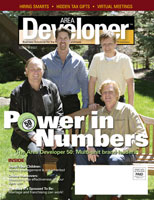Why should hiring employees be any different than buying paperclips?
What is the most important buying decision you'll ever make? When you choose a new site? Buy category management software? Invest in a hot new concept? Does something else come to mind?
Well, no matter what it is for you, there is a well-defined, proven system that ensures you make the best decision and get the highest possible return on that investment. This system is used by federal, state, and local governments, privately held and public corporations, charitable organizations and churches, startups, and established franchises everywhere for one reason - and one reason only - because it works.
It's in use every day, worldwide, to purchase everything from paperclips to airplanes. It works for tangibles like furniture and fixtures as well as for services like consulting and catering. Yet this proven system is routinely ignored when it comes to making the most important buying decisions any business ever faces: who gets hired.
A couple of reasons for this oversight come to mind. The first is that few business leaders realize that the standardized principles and practices they already use for purchasing and procurement also comprise an efficient, effective employee hiring system. Also at play here is a reluctance to systematize hiring in the mistaken belief that it's not possible to choose human capital the same way we acquire other products and services. This is why most hiring decisions still hinge on the result of gut-instinct interviews - in spite of the fact that interviews are scientifically proven to be only 8 percent more reliable than flipping a coin.
Could this reluctance to systematize hiring be why hourly employee turnover rates are so high? And why turnover in the management ranks is creeping higher every year? When the continuity of employees is key to developing the kind of relationships and service that earn customer loyalty, what does this bode for the future of your business?
If you don't like your answer to that question, it's time to take a page out of your Purchasing Procedures Manual and start "buying" employees with the same due diligence you apply to every other buying decision.
Spell out your purchasing specs
Be it a soft drink dispenser or a new store associate, you can't get what you need if you don't know exactly what you need it (or them) to do. Your purchasing specs for that new employee should go beyond the basic job description and spell out the following:
- The mental and physical capacities needed. Do you need a rocket scientist or someone with a GED? Does the applicant need to be able to leap tall buildings in a single bound, or just to stock the top shelf?
- The innate attitudes that ensure the employee likes the job and that your customers like the employee. The Harvard Business School determined that the four major factors critical to success on any job are: a) information, b) intelligence, c) skill, and d) attitude. Of these factors, they found that the first three account for only 7 percent of success, while attitude accounts for the remaining 93 percent. Let's face it; the quality of an organization can never exceed the quality of the people who make it up. That's why savvy employers hire for attitude and train for skills. So ask yourself, does the job call for a patient person who enjoys helping people or an assertive, energetic, and resourceful go-getter?
- The personality traits best suited to the job, your location, and the corporate culture. Is the company rigid or relaxed? Does the job call for a person who is competitive or a team player? The person who does the books should have a natural propensity for attention to detail. Your managers and planners should be big picture thinkers.
- The specific skills you need. Does the ideal candidate need to be bilingual? Able to do data entry? Operate a forklift? If yes, design a test to make sure you get what you need. Have the applicant translate a paragraph into Spanish or do five minutes' worth of data entry. (Just remember, you should hire for attitude and train for skills. While you can't take the time to teach someone to speak Spanish, it's well worth it to train a person with a great attitude in data entry.)
Solicit interest
With the specifications now in hand, the purchasing agent issues a Solicitation of Interest to find out who might provide the required products or services. This is analogous to advertising your job opening and, just like a good purchasing agent, you should research and use every possible resource. Ask for referrals from employees, customers, and vendors. Advertise on job boards, on your Web site, and in the local papers. Call the good people who used to work for you and see if they might want to come back. (The worst they could say is "no," and then you can ask them if they know of anyone else who might be interested.) If you always need new people, put in a 24-hour job hotline or an in-store employment kiosk, sign up for job fairs, rent a billboard, work with local schools, or create a radio jingle.
Evaluate bidders' qualifications
In the purchasing world, a qualified bidder is "an entity that has the capability in all respects to perform fully the contract requirements, as well as the integrity and reliability that will assure good faith performance." In the hiring world, this is the heart and soul of an effective and efficient employee selection system. It comprises a series of simple, logical steps that reduce employee turnover by ensuring better hiring decisions.
The first step is a telephone pre-screen to determine if applicants meet the most basic hiring criteria (i.e., the ability to work the hours needed, reliable transportation, citizenship or a green card, and willingness to work for the wage offered and take a drug test). There's no point in taking the time to see anyone in person who doesn't pass this step.
For those who pass the pre-screen, you then conduct the appropriate tests to determine if applicants meet the rest of the requirements called out in your specs. The first tests are for the required skills and capacities. Create and administer a math test, or give delivery truck driver applicants the wrong address and see if they still show up on time.
For those who pass this screen, standardized attitude and personality tests are also widely available to more narrowly identify those people best suited to the job. In fact, any number of vendors can automate part or all of a hiring system like this for you.
Issue your RFP
At this point, the purchasing agent invites qualified vendors to submit their Request for Pproposals. Similarly, you have identified a group of people you want to invite in for the big test: the interview.
An effective interview requires several steps. The first is to tell the applicant up front what is going to happen and what you want them to do. Above all, you want the person to be honest with you. You can accomplish this by saying something like:
"I'm going to be honest and open with you about this job and about our company and I hope you will be open and honest with me. It doesn't matter if you've ever been fired or had trouble with a boss or anything else. As long as you tell me, we can take it under consideration. But, if you don't tell me and we find a problem when we run a background check, I can't hire you. Do you understand what it is I want?"
Now, the applicant is positioned to answer your questions truthfully.
As for the questions, interviewers who get the best results use structured interview question sets. By asking each applicant the same questions, they're able to compare apples to apples and make the best hiring decisions.
Conduct your bid analysis
Now our "purchasing agent" will enter all the information from the proposals submitted into some kind of spreadsheet to analyze the data and make a decision. This is where you gather all the information you've collected about each applicant you've interviewed and do the same.
When making a final decision about who to hire, there are four things to consider in your analysis:
- test results should count for 30 percent;
- the interview should count for 30 percent;
- references should count for 30 percent (if you've thoroughly checked them); and
- your personal perception should count for 10 percent, because no matter how hard you may try to eliminate your biases, you still have them - and this is why so many people hire the best applicants instead of the best employees.
If the applicant scores poorly on any one of the four criteria, it's worth 100 percent and eliminates that applicant. On the other hand, a fantastic rating in any one of these areas can't, on its own, get someone hired. When you find good-to-great ratings in all four areas, you've found the right person for the job.
Make the award, letters of regret
At this point, our purchasing agent will issue a contract to the winning bidder. This document spells out all the terms and conditions, as well as the rights and obligations, of both parties. The applicant's signed and dated employment application form should cover all these issues. However, when you "award" the job you'll want to spell out a few more things to avoid the misunderstandings, disappointments, and assumptions that can lead to that person walking out on you, or to termination for cause.
First, tell the successful candidate why you chose them. Explain how their capacities, attitudes, personality traits, and skills are a good match for the job. When you set expectations early in this way, the person will either meet your standards or opt out by declining your offer. (Don't be upset, you just saved yourself a world of grief.)
Second, make sure the person understands all the terms and conditions of the offer: the position, earnings, start date, and any contingencies (physical exam, drug test, etc.).
Third, make sure the person knows the grounds for termination by reviewing all job-related rules and your company's performance appraisal form.
Finally, don't forget to notify the other candidates that you have decided to hire someone else. Thank them for applying and for the time they invested, and wish them well. After all, you don't want to create bad feelings in people who could be customers or have friends and relatives who are customers, vendors, or neighbors.
Make no mistake: every job applicant knows your job is to "buy" the best applicant you can. Don't disappoint them. Do what works. Use purchasing policies and procedures to decide who gets hired and watch your organization prosper.
Certified Speaking Professional Mel Kleiman is North America's foremost authority on how to recruit, select, and retain hourly employees. He is president of Humetrics, founded in 1976, which provides selection and retention tools as well as speaking, training, and consulting services. He also has authored five books, including the bestseller, Hire Tough, Manage Easy. For more information, visit www.melkleiman.com.
Share this Feature
Recommended Reading:
FRANCHISE TOPICS
- Multi-Unit Franchising
- Get Started in Franchising
- Franchise Growth
- Franchise Operations
- Open New Units
- Franchise Leadership
- Franchise Marketing
- Technology
- Franchise Law
- Franchise Awards
- Franchise Rankings
- Franchise Trends
- Franchise Development
- Featured Franchise Stories
FEATURED IN

Multi-Unit Franchisee Magazine: Issue 3, 2007

$225,000
$200,000





 The multi-unit franchise opportunities listed above are not related to or endorsed by Multi-Unit Franchisee or Franchise Update Media Group. We are not engaged in, supporting, or endorsing any specific franchise, business opportunity, company or individual. No statement in this site is to be construed as a recommendation. We encourage prospective franchise buyers to perform extensive due diligence when considering a franchise opportunity.
The multi-unit franchise opportunities listed above are not related to or endorsed by Multi-Unit Franchisee or Franchise Update Media Group. We are not engaged in, supporting, or endorsing any specific franchise, business opportunity, company or individual. No statement in this site is to be construed as a recommendation. We encourage prospective franchise buyers to perform extensive due diligence when considering a franchise opportunity.